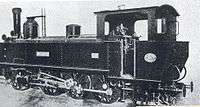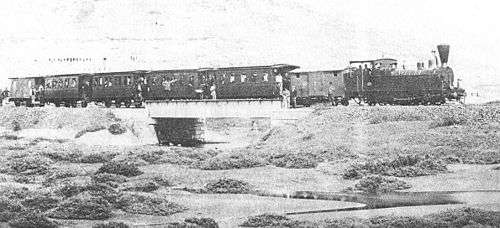Athens–Lavrion Railway
Athens–Lavrion Railway was a 1,000 mm (3 ft 3 3⁄8 in) (Metre gauge) railway line connecting downtown Athens with Eastern Attica and the mining town of Lavrion in Greece.
| Attica Railways (until 1926) | |||||||||||||||||||||||||||||||||||||||||||||||||||||||||||||||||||||||||||||||||||||||||||||||||||||||||||||||||||||||||||||||||||||||||||||||||||||||||||||||||||
|---|---|---|---|---|---|---|---|---|---|---|---|---|---|---|---|---|---|---|---|---|---|---|---|---|---|---|---|---|---|---|---|---|---|---|---|---|---|---|---|---|---|---|---|---|---|---|---|---|---|---|---|---|---|---|---|---|---|---|---|---|---|---|---|---|---|---|---|---|---|---|---|---|---|---|---|---|---|---|---|---|---|---|---|---|---|---|---|---|---|---|---|---|---|---|---|---|---|---|---|---|---|---|---|---|---|---|---|---|---|---|---|---|---|---|---|---|---|---|---|---|---|---|---|---|---|---|---|---|---|---|---|---|---|---|---|---|---|---|---|---|---|---|---|---|---|---|---|---|---|---|---|---|---|---|---|---|---|---|---|---|---|---|---|
 Locomotive Γ10 of Attica Railways | |||||||||||||||||||||||||||||||||||||||||||||||||||||||||||||||||||||||||||||||||||||||||||||||||||||||||||||||||||||||||||||||||||||||||||||||||||||||||||||||||||
| Technical | |||||||||||||||||||||||||||||||||||||||||||||||||||||||||||||||||||||||||||||||||||||||||||||||||||||||||||||||||||||||||||||||||||||||||||||||||||||||||||||||||||
| Line length | 74 km (46 mi) | ||||||||||||||||||||||||||||||||||||||||||||||||||||||||||||||||||||||||||||||||||||||||||||||||||||||||||||||||||||||||||||||||||||||||||||||||||||||||||||||||||
| Track gauge | 1,000 mm (3 ft 3 3⁄8 in) | ||||||||||||||||||||||||||||||||||||||||||||||||||||||||||||||||||||||||||||||||||||||||||||||||||||||||||||||||||||||||||||||||||||||||||||||||||||||||||||||||||
| |||||||||||||||||||||||||||||||||||||||||||||||||||||||||||||||||||||||||||||||||||||||||||||||||||||||||||||||||||||||||||||||||||||||||||||||||||||||||||||||||||
Attica Railways (1882–1926)
The contract between the Greek government and the Hellenic Company of Lavrion Metallurgies was signed in 1882. The line would be 76 km long, with a branch line from Heraklion to Kifissia. A new company, Attica Railways (Greek: Σιδηρόδρομοι Αττικής), was founded to take over the new line.[1]
The line from Attiki station[2] to Kifissia (a northern suburb) was opened on 2 February 1885 and was later extended further north to Strofyli. The main line to Lavrion was officially opened on 20 June 1885, although the section Keratea–Lavrion was in limited use before that date.
In 1889 the line was extended by 2 km towards the center of Athens, the station being located at Lavrion Square, near Omonoia Square. The section between Lavrion Square and Attica remained in use until 1926, when it was replaced by a tram line.
The section from Athens (Lavrion Square) to Heraklion was 9.2 km long, from Heraklion to Lavrion 56.85 km and from Heraklion to Strofyli 7.4 km. All sections were single track, with passing loops at most stations.
The main rolling stock depot and repair workshop were located at Attiki station, with additional facilities at Lavrion.
A short (273 m), single track spur branched off at a junction located 1 km beyond Heraklion station, followed by a 90° right curve and ending at Kalogreza or Nea Alexandreia station.[3] The branch line was constructed in or just after 1944 and served the local brown coal (lignite) mines of Kalogreza. It was closed in 1957, sharing the fate of Athens–Lavrion railway. There are no visible traces of the tracks left. Another branch line served Cambas Winery at Leontarion (Kantza). In the Lavrion mining area the line connected with the industrial networks of the two mining companies.
In 1910 Attica Railways were taken over by the Hellenic Electric Company.
Rolling stock

The passenger service to Lavrion consisted of 2 trains in each direction per day. The trains were hauled by Tubize 0-6-2T steam locomotives, delivered between 1885 and 1889. Later (1900–1925) ten 2-6-0T locomotives were procured in four batches, one of them from Vassiliadis Works in Piraeus and the remaining nine from Krauss in Germany. Two additional old Tubize 0-6-2T locomotives were bought from Thessaly Railways in 1919 and were converted to 2-6-2T.
Part of Piraeus, Athens and Peloponnese Railways (1929–1962)
| Attica Railways successors (1931) | |||||||||||||||||||||||||||||||||||||||||||||||||||||||||||||||||||||||||||||||||||||||||||||||||||||||||||||||||||||||||||||||||||||||||||||||||||||||||||||||||||||||||||||||||||||||||||||||||||||||||||||||||||||||||||||||||||||||||||||||
|---|---|---|---|---|---|---|---|---|---|---|---|---|---|---|---|---|---|---|---|---|---|---|---|---|---|---|---|---|---|---|---|---|---|---|---|---|---|---|---|---|---|---|---|---|---|---|---|---|---|---|---|---|---|---|---|---|---|---|---|---|---|---|---|---|---|---|---|---|---|---|---|---|---|---|---|---|---|---|---|---|---|---|---|---|---|---|---|---|---|---|---|---|---|---|---|---|---|---|---|---|---|---|---|---|---|---|---|---|---|---|---|---|---|---|---|---|---|---|---|---|---|---|---|---|---|---|---|---|---|---|---|---|---|---|---|---|---|---|---|---|---|---|---|---|---|---|---|---|---|---|---|---|---|---|---|---|---|---|---|---|---|---|---|---|---|---|---|---|---|---|---|---|---|---|---|---|---|---|---|---|---|---|---|---|---|---|---|---|---|---|---|---|---|---|---|---|---|---|---|---|---|---|---|---|---|---|---|---|---|---|---|---|---|---|---|---|---|---|---|---|---|---|---|---|---|---|---|---|---|---|---|---|---|---|---|---|---|---|---|
| Technical | |||||||||||||||||||||||||||||||||||||||||||||||||||||||||||||||||||||||||||||||||||||||||||||||||||||||||||||||||||||||||||||||||||||||||||||||||||||||||||||||||||||||||||||||||||||||||||||||||||||||||||||||||||||||||||||||||||||||||||||||
| Track gauge | 1,000 mm (3 ft 3 3⁄8 in) metre gauge | ||||||||||||||||||||||||||||||||||||||||||||||||||||||||||||||||||||||||||||||||||||||||||||||||||||||||||||||||||||||||||||||||||||||||||||||||||||||||||||||||||||||||||||||||||||||||||||||||||||||||||||||||||||||||||||||||||||||||||||||
| |||||||||||||||||||||||||||||||||||||||||||||||||||||||||||||||||||||||||||||||||||||||||||||||||||||||||||||||||||||||||||||||||||||||||||||||||||||||||||||||||||||||||||||||||||||||||||||||||||||||||||||||||||||||||||||||||||||||||||||||
In 1926 the lines to Lavrion and Kifissia was taken over by the Electric Transport Company, member of Power and Traction Finance Company. In 1929 the line from Heraklion to Lavrion was transferred to Piraeus, Athens and Peloponnese Railways or SPAP.
When the railway was operated by SPAP trains to Lavrion departed from Athens Peloponnese Station. SPAP trains initially used the Attiki station to Heraklion section without stopping at intermediate stations until 1931, when SPAP constructed a line from the station of Kato Liossia (later Agioi Anargyroi) to Heraklion. Between 1929 and 1931 SPAP trains would access the Lavrion line at Attiki station using a temporary short connection passing over the standard gauge line north of Athens Central ("Larissis") station.
SPAP took possession of the ten 2-6-0T (Vassiliadis/Krauss) locomotives while the remaining were used by IEM for the Attiki–Kifissia–Strofyli service.
In 1944 the line was damaged and was reopened only in 1952, with three trains in each direction on weekdays and an extra passenger train on weekends. Passenger trains consisted of Uerdingen/MAN railbuses.[4] Freight trains still used steam traction.
The line was closed to passenger traffic in 1957, due to political lobbying by private bus owners.[5] Limited freight and special passenger trains ran for a few more years. In 1962 the connection between Kato Liosia and Heraklion was severed due to the construction of the new Athens–Thessaloniki highway and the line was abandoned.
Preservation
Small sections of the line survive at various locations. Museum railways of Attica Co. (Greek: Εταιρεία Μουσειακών Σιδηροδρόμων Αττικής or Greek: ΕΜΣΑ), a preservation society in the form of a non-for-profit company, maintains two small sections of 3 km each, one near Kalyvia and one near Keratea. [6]
Reopening
In 2016 a nine station, 32 km extension of the Proastiakos Athens commuter rail network from the existing Koropi station to Lavrio was announced, at a cost of €350 million, connecting 300,000 more people to the rail network. [7]
See also
- Lavrion Square-Strofyli railway
- Attica Railways
- Piraeus, Athens and Peloponnese Railways
Notes and references
- 130 Χρόνια Ηλεκτρικοί Σιδηρόδρομοι Αθηνών-Πειραιώς Α.Ε. (130 years of Athens-Piraeus electric railways). ISAP. 1999–2005. pp. 113–115. ISBN 978-960-86477-0-1.
- A location in Athens formerly called Kassida and promptly renamed Attica (Attiki, Greek: Αττική) after the railway, even today called Attica Square, not to be confused with the Attica Region served by the line.
- G. Nathenas; A. Kourbelis; T. Vlastos; S. Kourouzidis; V. Katsareas; P. Karamanis; A. Klonos; N. Kokkinos (2007). Από τα Παμφορεία στο Μετρό (in Greek). 2. Athens: Μίλητος (Militos). p. 761. ISBN 978-960-8460-91-1.
- I. Zartaloudis; D. Karatolos; D. Koutelidis; G. Nathenas; S. Fasoulas; A. Filippoupolitis, A. (1997). Οι Ελληνικοί Σιδηρόδρομοι (Hellenic Railways) (in Greek). Μίλητος (Militos). pp. 46–47. ISBN 978-960-8460-07-2.
- I. Zartaloudis; D. Karatolos; D. Koutelidis; G. Nathenas; S. Fasoulas; A. Filippoupolitis, A. (1997). Οι Ελληνικοί Σιδηρόδρομοι (Hellenic Railways) (in Greek). Μίλητος (Militos). p. 20. ISBN 978-960-8460-07-2.
- "Μουσειακός Σιδηρόδρομος Αττικής". Retrieved 14 March 2020.
- "Suburban Train to Pull in to Lavrio Port by 2019". GTP. 29 November 2016. Retrieved 8 March 2019.